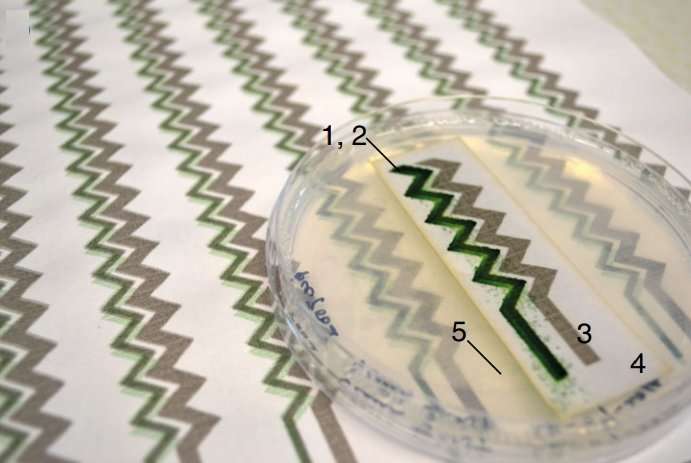November 27, 2017 feature
Digitally printed cyanobacteria can power small electronic devices

(Phys.org)—Researchers have used a simple inkjet printer to print a "bio-ink" of cyanobacteria onto a conductive surface, creating a biophotovoltaic cell. Unlike conventional photovoltaic cells that operate only when exposed to light, the cyanobacteria can generate an electric current both in the dark and in response to light. The researchers expect that the cell may serve as an environmentally friendly power supply for low-power devices such as biosensors, and can even be scaled up to print a bioenergy wallpaper.
The scientists, at Imperial College London and University of Cambridge, have published a paper on the new biophotovoltaic cell in a recent issue of Nature Communications.
"Our biophotovoltaic device is biodegradable and in the future could serve as a disposable solar panel and battery that can decompose in our composts or gardens," coauthor Marin Sawa at University of Arts London and Imperial College London told Phys.org. "Cheap, accessible, environmentally friendly, biodegradable batteries without any heavy metals and plastics—this is what we and our environment really need but don't have just yet, and our work has shown that it is possible to have that."
In general, biophotovoltaic cells contain some type of cyanobacteria or algae that is phototrophic, meaning it converts light into energy. However, even in the dark these organisms continue to generate some energy by metabolizing their internal storage reserves. So when the organisms are connected to a non-biological electrode, they can function as either a "bio solar panel" when exposed to light or a "solar bio-battery" in the dark.
Currently one of the biggest challenges facing biophotovoltaic cells is producing them on a large scale. Typically, the organisms are deposited onto an electrode surface from a bulky liquid reservoir. In the new study, the researchers demonstrated that inkjet printing can be used to print both the carbon nanotube electrode surface and the cyanobacteria on top of it, while allowing the bacteria to remain fully viable. This approach not only allows the cells to be fabricated quickly, but the set-up is also more compact and allows for greater precision in cell design.
With these advantages, the inkjet-printed biophotovoltaic cells can generate a maximum current density that is 3-4 times higher than cells fabricated using conventional methods. To demonstrate, the researchers showed that nine connected cells can power a digital clock or generate flashes of light from an LED, illustrating the ability to produce short bursts of relatively high power. The researchers also showed that the cells can generate a continuous power output over the course of a 100-hour period consisting of light and dark cycles.
In the future, the researchers plan to develop thin-film biophotovoltaic (BPV) panels and also explore potential applications as integrated power supplies in the areas of point-of-care medical diagnostics and environmental monitoring, both of which benefit from disposable, environmentally friendly biosensors. Another potential application is a bioenergy wallpaper.
"The bioenergy wallpaper is a scaled-up application of our BPV system," Sawa said. "The wallpaper will have carbon-based conductive patterns with electron-producing cyanobacteria. It turns an interior surface into an energy harvester to drive low-power applications like LED lights and/or biosensors, which can, for example, monitor indoor air quality."
The researchers also expect that the power output of the cells can be improved in a variety of ways, such as by improving circuit conductivity, optimizing cell design, and using more resilient organisms.
More information: Sawa, M., Fantuzzi, A., Bombelli, P., Howe, C., Hellgardt, K., Nixon, P. "Electricity generation from digitally printed cyanobacteria." Nature Communications. DOI: 10.1038/s41467-017-01084-4
Journal information: Nature Communications
© 2017 Phys.org





















